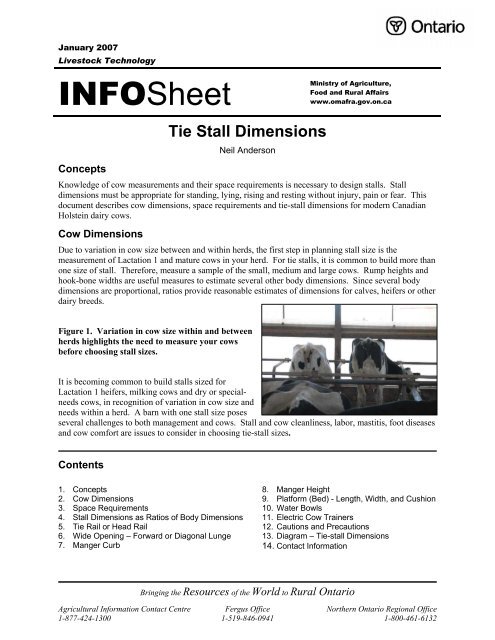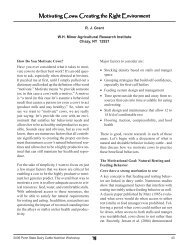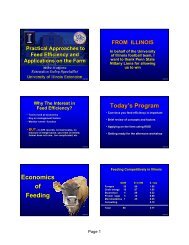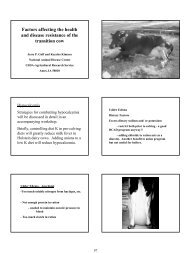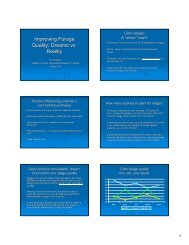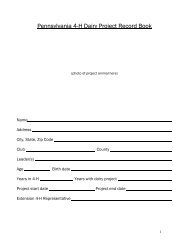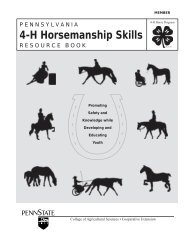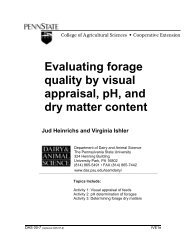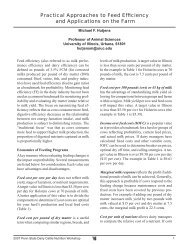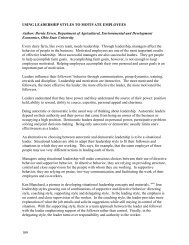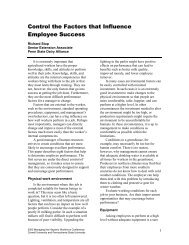Tie Stall Dimensions
Tie Stall Dimensions
Tie Stall Dimensions
Create successful ePaper yourself
Turn your PDF publications into a flip-book with our unique Google optimized e-Paper software.
January 2007<br />
Livestock Technology<br />
INFOSheet<br />
Concepts<br />
<strong>Tie</strong> <strong>Stall</strong> <strong>Dimensions</strong><br />
Neil Anderson<br />
Ministry of Agriculture,<br />
Food and Rural Affairs<br />
www.omafra.gov.on.ca<br />
Knowledge of cow measurements and their space requirements is necessary to design stalls. <strong>Stall</strong><br />
dimensions must be appropriate for standing, lying, rising and resting without injury, pain or fear. This<br />
document describes cow dimensions, space requirements and tie-stall dimensions for modern Canadian<br />
Holstein dairy cows.<br />
Cow <strong>Dimensions</strong><br />
Due to variation in cow size between and within herds, the first step in planning stall size is the<br />
measurement of Lactation 1 and mature cows in your herd. For tie stalls, it is common to build more than<br />
one size of stall. Therefore, measure a sample of the small, medium and large cows. Rump heights and<br />
hook-bone widths are useful measures to estimate several other body dimensions. Since several body<br />
dimensions are proportional, ratios provide reasonable estimates of dimensions for calves, heifers or other<br />
dairy breeds.<br />
Figure 1. Variation in cow size within and between<br />
herds highlights the need to measure your cows<br />
before choosing stall sizes.<br />
It is becoming common to build stalls sized for<br />
Lactation 1 heifers, milking cows and dry or specialneeds<br />
cows, in recognition of variation in cow size and<br />
needs within a herd. A barn with one stall size poses<br />
several challenges to both management and cows. <strong>Stall</strong> and cow cleanliness, labor, mastitis, foot diseases<br />
and cow comfort are issues to consider in choosing tie-stall sizes.<br />
Contents<br />
1. Concepts<br />
2. Cow <strong>Dimensions</strong><br />
3. Space Requirements<br />
4. <strong>Stall</strong> <strong>Dimensions</strong> as Ratios of Body <strong>Dimensions</strong><br />
5. <strong>Tie</strong> Rail or Head Rail<br />
6. Wide Opening – Forward or Diagonal Lunge<br />
7. Manger Curb<br />
8. Manger Height<br />
9. Platform (Bed) - Length, Width, and Cushion<br />
10. Water Bowls<br />
11. Electric Cow Trainers<br />
12. Cautions and Precautions<br />
13. Diagram – <strong>Tie</strong>-stall <strong>Dimensions</strong><br />
14. Contact Information<br />
Bringing the Resources of the World to Rural Ontario<br />
Agricultural Information Contact Centre Fergus Office Northern Ontario Regional Office<br />
1-877-424-1300 1-519-846-0941 1-800-461-6132
Figure 2. Several cow measurements taken on<br />
standing cows are useful for building stalls. Other<br />
essential measurements are imprint length and<br />
imprint width of resting cows.<br />
Table 1 shows measurements of mature Canadian<br />
Holsteins at a local dairy herd and some calculated<br />
proportions. For example, mature cows had a rump<br />
height of 60 inches, a nose-to-tail length of 8.5 feet<br />
and a hook-bone width of 25 inches. Their weight<br />
exceeded 1,550 pounds.<br />
Table 1. The table shows body dimension, example measurements for mature Holsteins and ratios<br />
to rump height and hook-bone width.<br />
Body Dimension Inches Proportions<br />
Nose-to-tail length 102 (range 96-110) 1.6 x rump height<br />
Imprint length – resting 72 (68-76) 1.2 x rump height<br />
Imprint width 52 (48-54) 2 x hook-bone width<br />
Forward lunge space 24 (23-26) 0.4 x rump height<br />
Stride length when rising 18 0.3 x rump height<br />
Rump height – mature Median 60 (range 58-64)<br />
Rump height – Lactation 1 Median 58, top 25% - 59<br />
Stance – front-to-rear feet 60 (range 58-64) 1.0 x rump height<br />
Withers (shoulder) height 60 (range 58-64) 1.0 x rump height<br />
Hook-bone width 26 (range 24-27)<br />
Space Requirements<br />
Observations of cows freely lying and rising reveal that a mature Canadian Holstein cow uses 102 x 52<br />
inches of living space and another 20 (16-24) inches of open forward space for lunging motions.<br />
Several cow dimensions that define this living space include those shown in Figure 2 plus imprint length<br />
and width.<br />
Nose-to-tail length describes the measurement from the tail to the nose of a cow standing with her head<br />
forward. A cow has a normal crook in her neck when lying and her nose-to-tail length is less than while<br />
standing.<br />
Imprint length describes the length from folded<br />
foreknee to tail while lying in the narrow position. It<br />
defines the bed length needed for resting with all<br />
body parts on the stall. Imprint length is greater<br />
when the cow extends her front legs forward in<br />
normal resting positions.<br />
Figure 3. Imprint length extends from the folded<br />
foreknee to the tail. This length defines the bed<br />
length of a stall.<br />
Ministry of Agriculture, Food and Rural Affairs Page 2 <strong>Tie</strong> <strong>Stall</strong> <strong>Dimensions</strong><br />
© January 2007
When resting in the narrow position, the point of the hock on the upper hind leg and the extension of the<br />
abdomen on the opposite side define the imprint width. This width is the minimum stall width for a<br />
resting cow. However, for improved comfort, most new tie-stall barns are being built with stalls wider<br />
than the imprint width of a cow in the narrow resting<br />
position.<br />
Figure 4. For the rear view of the cow in the<br />
photo, imprint width extends from the left hock to<br />
the right abdomen – a distance of about 52 inches<br />
for this cow. It increases when the rear legs extend<br />
outwards or the cow reclines in wide resting<br />
positions.<br />
The space needed for lying and rising motions<br />
(lunging) extends forward, downward and upward for<br />
head lunge and bob, vertically and forward for<br />
standing and laterally for hindquarter movements.<br />
Knowledge of this space is essential for properly<br />
sizing the opening at the front of tie stalls, positioning<br />
tie rails, choosing the shape and dimensions of stall<br />
dividers and avoiding hazards when turning out of<br />
stalls.<br />
Figure 5. While rising freely on pasture, a cow<br />
uses the forward, downward and vertical space<br />
outlined by the white lines in the photograph.<br />
While rising, this cow lunged forward about 22%<br />
of her resting nose-to-tail length.<br />
<strong>Stall</strong> <strong>Dimensions</strong> as Ratios of Body <strong>Dimensions</strong><br />
Although nose-to-tail length is essential, it is a difficult dimension to gather. Since hook-bone width and<br />
rump height are easy to measure and since many body dimensions are proportional, these two cow<br />
dimensions are useful references for sizing stalls. Table 2 shows stall dimensions, estimated relationships<br />
to body dimensions and example calculations for mature Holsteins in a study herd. Figure 13, at the end<br />
of this document, is a drawing showing a single, tie-rail stall and several example dimensions for large,<br />
medium and small Holsteins. Measure your cows before choosing stall sizes.<br />
The standing surface for the feet is the reference for vertical placement of the tie rail and the bottom of the<br />
manger. The tie rail forward location is a horizontal measurement from the gutter curb.<br />
Table 2. The table shows stall dimensions, estimated relationships to body dimensions and example<br />
calculations for mature Holsteins in a study herd.<br />
<strong>Stall</strong> Dimension<br />
Ratio and Reference<br />
Body Dimension<br />
An Example<br />
a median cow<br />
Bed length = imprint length 1.2 x rump height 1.2 x 60 = 72 in.<br />
<strong>Tie</strong> rail height above cow’s feet 0.80 x rump height 0.80 x 60 = 48 in.<br />
*<strong>Stall</strong> width = imprint width + 2.0 x hook-bone width 2 x 26 = 52 in.<br />
* Producers are building most new tie stalls wider than this minimum width. The most common<br />
minimum width is 54 inches.<br />
Ministry of Agriculture, Food and Rural Affairs Page 3 <strong>Tie</strong> <strong>Stall</strong> <strong>Dimensions</strong><br />
© January 2007
<strong>Tie</strong> Rail or Head Rail<br />
A tie rail (sometimes called a head rail) is the pipe used as the attachment for the tie chain. It controls the<br />
forward location of a cow while standing in the stall and often acts as the water line. Proper location of<br />
the tie rail lets a cow stand straight (parallel to the dividers) with all four feet in the stall and rise or lie<br />
without contacting it. The vertical location above the bed is about 0.8 x rump height. It mounts forward<br />
of the manger curb and over the manger. Standing in the gutter, diagonal standing or neck injuries are the<br />
most obvious signs of incorrect placement of the tie rail or obstructions at the front of the stall. Canarm-<br />
BSM Agri (Arthur, ON), Donald Horst & Sons (Elmira, ON), Norwell Dairy Systems, (Drayton, ON) and<br />
MSD Stabling (Williamsford, ON) manufacture and<br />
sell stabling that allows adjustment of the height and<br />
forward location of the tie rail. The tie chain with<br />
snap should extend only to the height of the manger<br />
curb.<br />
Figure 6. A tie rail placed 48 inches above the<br />
mattress and 86 inches forward of the gutter curb<br />
allows medium size cows (about 58-inch rump<br />
height) to stand straight in the stall. While<br />
standing idly chewing their cuds, their poll will be<br />
at tie-rail height and behind it and most of their<br />
head will extend below and forward of the tie rail.<br />
Larger cows will stand diagonally in stalls with<br />
those measurements.<br />
In tie stalls, cleanliness is always a challenge because cows step forward while eating and defecate during<br />
the time they are standing forward. Although it has some drawbacks, a front on the manger would keep<br />
feed closer to cows and may reduce the reaching-for-feed and stepping-forward seen with sweep-in<br />
mangers. An alternative with high tie-rail stalls is to locate the tie rail closer to the manger curb to reduce<br />
the frequency of cows stepping forward while eating. Because of the height, there is less need for the rail<br />
to be further forward of the manger curb as there is with low tie rails.<br />
Wide Opening – Forward or Diagonal Lunge<br />
When rising or lying normally, a mature Holstein uses about 10 feet of space measured from her tail to<br />
her most forward lunge distance. The forward space must be unobstructed for frontward lunging and<br />
bobbing of the head.<br />
Short beds or stalls with obstructions in the lunging space lead to diagonal (corner-to-corner) standing,<br />
lying and rising. Cows still lunge forward relative to their body direction, but diagonal or sidewise to the<br />
stall. Since the top pipe of the divider becomes a restraint when cows lunge through it, it must have a<br />
wide opening to permit easy rising or lying, but be low enough to restrict passage through it. From<br />
mattress top to the bottom of this pipe is usually 46 inches in many new stalls. The divider also must<br />
have a low mount at manger curb height that does not<br />
inhibit the ability to lunge over it. The measurement<br />
from the top of the mattress to the top of the bottom<br />
pipe should be less than 12 inches.<br />
Figure 7. In most barns, the divider provides<br />
support for milk lines and separation of cows in<br />
adjacent stalls. This divider leaves about 30 inches<br />
of space for cows to back into an adjacent stall<br />
when exiting. The top pipe drops down at the back<br />
so a cow can easily swing her head over it. This<br />
style is suitable for herds feeding total mixed<br />
rations.<br />
Ministry of Agriculture, Food and Rural Affairs Page 4 <strong>Tie</strong> <strong>Stall</strong> <strong>Dimensions</strong><br />
© January 2007
Manger Curb<br />
A manger curb restricts the forward location of a cow lying in the stall, controls the movement of bedding<br />
into feed and retains feed in the manger. It defines the forward limit of the bed length measured from the<br />
gutter curb.<br />
Concrete and wood have been the most common<br />
materials used for manger curbs. Because of their<br />
height, manger curbs interfere with the normal stride<br />
taken during rising. However, some cows stride into<br />
the manger and a slippery surface poses a hazard.<br />
Figure 8. A cow-friendly manger curb has beveled<br />
corners. The curb acts as an obstruction to<br />
forward extension of the legs. To get room for this<br />
normal behaviour, cows lie diagonally in their stalls<br />
with their front legs stretched into the neighboring<br />
bed.<br />
It is common to build a 10-inch curb height measured<br />
from the concrete platform to the top of the curb. This measurement decreases to 8 or less inches on the<br />
cow side with the addition of a rubber-filled mattress or ample bedding. Despite the 8-inch height, many<br />
cows will extend their legs forward into the manger. Therefore, the curb should have rounded, beveled or<br />
smoothed edges. Recently, a plastic brisket locator used in free stalls has been modified for use as a<br />
manger curb. A flat manger surface and a wooden curb save construction costs. With this technique,<br />
producers attach the board (e.g., 2 x 4 or 2 x 6) to the support posts for the stall dividers.<br />
Manger Height<br />
The manger surface is 4 inches higher than the level of the cow’s feet. Although this height compromises<br />
a cow’s ability to bob her head when lying or rising, it is chosen to maximize foot health of the front feet.<br />
In barns with the manger at or below bed height, the odds are greater that cows will have sole ulcers on<br />
the inner claws of the front feet. The increased risk is related to changes to weight bearing of the inner<br />
claws when a cow spreads her front feet apart (laterally) to lower her body while reaching for feed. The<br />
4-inch manger height minimizes the foot-spreading behaviour and the foot problems. The elevated<br />
manger also reduces the frequency of cows kneeling to reach feed.<br />
Platform (Bed) – Length, Width and Cushion<br />
Bed length should equal imprint length – about 1.2 times rump height. For example, most Lactation 1<br />
heifers have a rump height of 58-59 inches and would need about a 70-inch bed. Mature cows measuring<br />
60 inches at the rump would need a 72-inch bed. For stalls with rubber-filled mattresses, effective bed<br />
length is the distance from gutter curb to manger curb.<br />
For stalls with bedding keepers and bedding kept<br />
below the height of the bedding keeper, effective bed<br />
length is measured from the inside of the keeper to the<br />
manger curb. If the bedding keeper is kept covered<br />
with long straw, then stall length could be measured<br />
from the gutter side of the bedding keeper.<br />
Figure 9. <strong>Stall</strong>s with ample width and length allow<br />
freedom to rest in normal positions. Because of<br />
longer chains, cows are cleaner from self-grooming<br />
and they show more visible signs of estrous.<br />
The minimum bed length described above will not<br />
permit cows to lie straight with their forelegs extended. They will lie diagonally or lie with their<br />
rumps over the gutter to attain this normal resting posture. However, stalls are seldom built with<br />
longer beds because they pose challenges with stall and cow cleanliness and the risk of mastitis.<br />
Ministry of Agriculture, Food and Rural Affairs Page 5 <strong>Tie</strong> <strong>Stall</strong> <strong>Dimensions</strong><br />
© January 2007
Minimum bed width should equal imprint width – about two times hook-bone width. But minimum<br />
width doesn’t allow cows to lay over in wider resting positions. Because of this limitation, astute<br />
producers are building tie stalls wider than one would find in free stall barns. A 54-inch wide stall is<br />
becoming common for small cows, 57-inch for medium cows and 60-inch stalls for dry cows or the very<br />
largest cows in the herd.<br />
A thick bed of straw has been the most common cushioning surface for tie stalls. However, rubber-filled<br />
mattresses are becoming the most popular subsurface for stalls. These mattresses still need a covering<br />
with chopped straw, sawdust or kiln-dried softwood shavings. Hardwood shavings or wood chips are<br />
unacceptable bedding materials. Rubber mats provide minimal cushioning and they require a very<br />
generous (3 inches) cover with bedding if used in stalls.<br />
Water Bowls<br />
Nose-to-poll length establishes the space required for access to a water bowl. This length is about 24<br />
inches for mature cows. Therefore, the distance from the top of the water bowl to any obstruction above<br />
it should be greater than 24 inches. With higher tie<br />
rails, bowls can be mounted to provide ample access<br />
for drinking and adequate space below for cleaning<br />
mangers. If a manger divide is installed, and the bowl<br />
mounted within it, it must have about a 30-inch<br />
opening for easy access to the water. Similar access<br />
must be available when bowls are mounted over the<br />
bed and within the stall divider.<br />
Figure 10. The distance from the top of the water<br />
bowl to the vertical obstruction is greater than the<br />
nose to poll length of the cows. This assures easy<br />
access to water. There is also adequate space below<br />
the bowl for sweeping the mangers.<br />
Electric Cow Trainers<br />
The proper placement of trainers contributes to stall and cow cleanliness and udder health. Another<br />
benefit relates to improved claw health from cleaner beds.<br />
Figure 11. For Holsteins in stalls with 70 - 72-inch<br />
platforms, the trainer should be 48 inches (range 47<br />
- 49) forward of the gutter curb. For Jerseys in<br />
stalls with 62 - 66-inch platforms, the forward<br />
location is 42 inches (range 41 - 43). Remember<br />
that they are trainers and should be located about 2<br />
inches above the chine for a 24 - 48-hour training<br />
period. After training, raise them to 4 inches.<br />
They can be lowered for 24 hours of remedial<br />
training but must be raised again afterwards. The<br />
trainer must have a height adjustment for each<br />
cow.<br />
Thomas Oswald, a Swiss Researcher, showed tie stalls were not any dirtier with operation of trainers two<br />
days a week compared to 7 days a week. Oswald also showed that 90% of all contacts with the bow did<br />
not happen during urinating or defecating. He concluded that operation of trainers one or two days per<br />
week should be a reasonable way of reducing the stress associated with the electric shocks.<br />
Incorrectly positioned trainers prevent some cows from showing strong signs of heat, making heat<br />
detection difficult and contributing to poor reproductive performance. The cow trainer bow must be<br />
raised to a higher position when a cow is expected to be or is in heat. Trainers must have secure<br />
attachment so they do not fall upon a cow and cause abusive damage. The distance between the trainer<br />
bow and the cow must be at least 5 cm (2 inches).<br />
Ministry of Agriculture, Food and Rural Affairs Page 6 <strong>Tie</strong> <strong>Stall</strong> <strong>Dimensions</strong><br />
© January 2007
The directions for installation should include the<br />
indications for use. For example, electric trainers will<br />
train cows to step back when arching their backs for<br />
defecation or urination. The purpose is to position<br />
cows so they defecate or urinate in the gutter rather<br />
than the stall bed. In addition, there are contradictions<br />
for use. Electric trainers are not to be used to restrict<br />
the normal eating, standing or lying behaviour of<br />
cows. Trainers must not restrict access to feed or<br />
water.<br />
Figure 12. The trainer is located at the chine and<br />
slightly ahead of the point where the back begins to<br />
arch when a cow defecates or urinates. The<br />
trainers should be located at least 2 inches (five cm)<br />
above the chine.<br />
Cautions and Precautions<br />
A comfortable and safe stall requires attention to detail in construction and maintenance. A stall is a unit<br />
and all features must be maintained to assure cow safety.<br />
Cows have been found in the mangers at one new barn with the higher tie rails. The stalls have rubber<br />
mats and straw bedding; water bowls are over the bed; and ceramic tiles line the bottoms of mangers.<br />
Many beds are wet from slopping at the water. For cows in those wet beds, both front feet have slippery<br />
surfaces (mat and tile manger) when they stride to rise or reach for feed. Could the slipperiness be the<br />
reason for the misadventures? At another farm, one row of new stalls had rubber mats and the other<br />
rubber-filled mattresses. Both had ample straw for a top cover of bedding. However, cows on the rubber<br />
mats quickly developed hock sores despite the owners’ efforts to use more bedding in that row. Cows<br />
need a cushioning surface and one with good traction to avoid injuries. Usually, cows exiting through<br />
stalls with high tie rails are unharmed. However, some have been. One hazard to avoid is the clamp that<br />
fixes the chain to the tie rail. It should be oriented so the “tails” of the bracket extend fore and aft rather<br />
than downwards and upwards.<br />
At a farm with a narrow opening in the stall divider, a cow got her head trapped under it. At another, a<br />
cow wrapped her front leg in a chain. On both farms, the chains were longer than recommended. They<br />
extended below the manger curb. The owners shortened the chains. Long chains give cows freedom to<br />
show strong signs of estrous. Most producers shorten the chain by wrapping it around the tie rail for 24<br />
hours. This prevents cows from jumping over dividers.<br />
<strong>Stall</strong> cleanliness is a concern with the larger stalls and longer chains. For sure, stall and cow cleanliness<br />
were design criteria that led to low tie rails, short tie-chains, comfort stalls, stanchions, short beds and<br />
narrow stalls. However, the old stalls also challenged cows through injuries, discomfort and stress that<br />
decreased their longevity and production. That’s why producers are trying new, larger stalls with higher<br />
tie rails and longer tie chains. In a recent comparison at one farm, the frequency of manure on the stalls<br />
was the same in the new and the old stalls.<br />
Diet and consistency of manure affect stall cleanliness and usefulness of electric trainers. The posture<br />
and the arc in her spine of a defecating cow vary with feeds and feeding husbandry. Generally, a diet of<br />
dry hay and some corn silage leads to firm manure - and an arc in the spine during defecation. There may<br />
be no arc in the spine and very slight elevation of the tail with diets that lead to liquid manure or as fecal<br />
consistency approaches diarrhea. The solution to cow cleanliness concerns and apparent failure of<br />
trainers may be feeding for firmer manure and regaining the arced posture for defecation.<br />
Ministry of Agriculture, Food and Rural Affairs Page 7 <strong>Tie</strong> <strong>Stall</strong> <strong>Dimensions</strong><br />
© January 2007
Figure 13. The diagram shows a tie stall with a head rail. The table shows variations in stall<br />
dimensions for Holstein cows - First Lactation, Milking and Dry Cows. Nonetheless, it’s good<br />
advice to measure your cows before deciding on stall sizes.<br />
(Courtesy of Harold House, OMAFRA)<br />
Companion Infosheets<br />
1. Cow Behaviour to Judge Free <strong>Stall</strong> and <strong>Tie</strong> <strong>Stall</strong> Barns<br />
2. Free <strong>Stall</strong> <strong>Dimensions</strong><br />
Contact Information<br />
Dr. Neil Anderson, Lead Veterinarian – Disease Prevention, Ruminants<br />
Animal Health and Welfare Group, Livestock Technology Branch<br />
Ontario Ministry of Agriculture, Food and Rural Affairs<br />
Wellington Place, R. R. # 1, Fergus, Ontario N1M 2W3<br />
Tel.: (519) 846-0941, Fax: (519) 846-8101<br />
E-mail: neil.anderson@ontario.ca<br />
Webpage: http://www.omafra.gov.on.ca/english/livestock/dairy/facts/info_tsdimen.htm<br />
Ministry of Agriculture, Food and Rural Affairs Page 8 <strong>Tie</strong> <strong>Stall</strong> <strong>Dimensions</strong><br />
© January 2007


